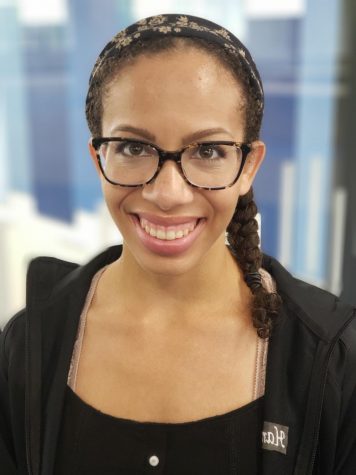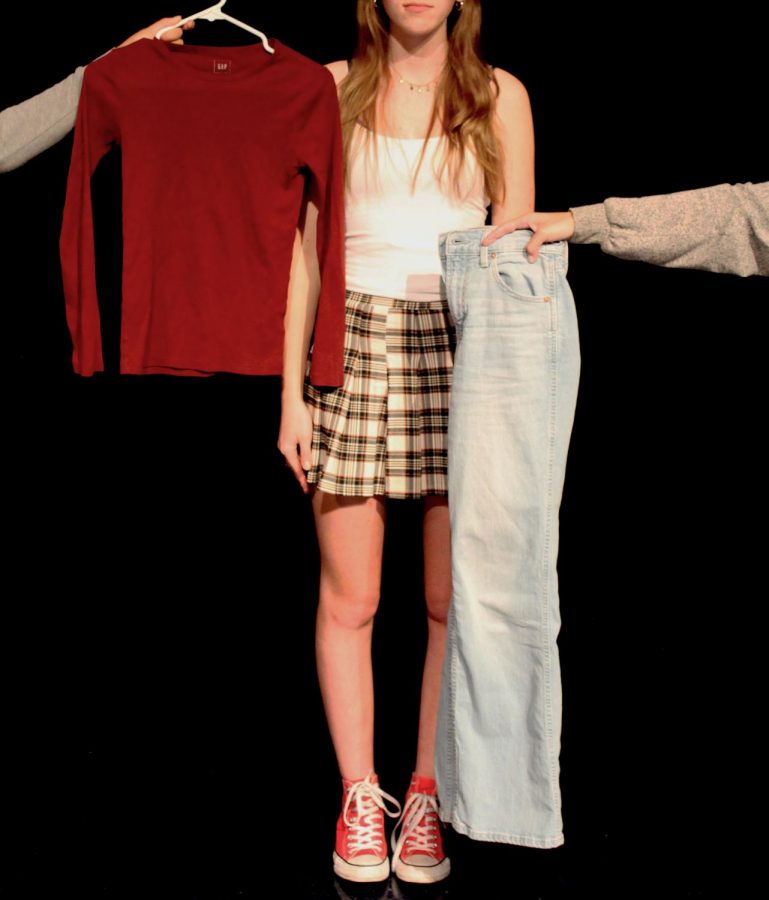Revealing women’s reality
Photo by Kyra Keena
Exposing sexism:
67% of Americans say that when it comes to gender discrimination, the bigger problem is people not seeing it where it really does exist, rather than people seeing discrimination where it does not exist, according to a study from the Pew Research Center. Both men and women can face sexism, but for female LZHS students, they see misogyny in dress codes, they see it on social media, and they see it in reports of sexual assault. By sharing their experiences with sexism, their voices can bring the reality of sexism to people’s attention.
Revealing sexism in the dress code:
The first school dress code law in the U.S. was established in 1969. The U.S. Supreme Court case, known as Tinker vs. Des Moines Independent School District, involved several high school students who wore black armbands to school in a planned protest against the Vietnam War. The Court decided that schools were allowed to limit student expression only if it would be disruptive to learning environments.
However, with 14.1% of female LZHS students saying they have been dress coded, compared to the 1.8% of male LZHS students who reported in a Bear Facts Student Media survey they have been dress coded, some students like Mia Danca, senior, say that unfortunately, the intentions of dress codes differ between girls and boys.
“I think that [dress codes are] almost there to embarrass girls, to lean more towards protecting other people from feeling odd, even though it should be the other way around. We shouldn’t be reprimanded for wearing something that we would normally wear outside of school anyway. We have those clothes and we consider them, in our personal opinion, how we want to express ourselves. We should be free to do that,” Danca said.
Middle school dress codes were the “first ever smack in the face example” of sexism for Holly, a sophomore whose name has been changed to protect her identity.
“It was one of the hottest days and we didn’t have air conditioning. So, I wore a tank top to school. I was 10 years old [when] a male teacher came up to me and said I couldn’t wear [it],” Holly said. “I was like, ‘What do you mean? It’s hot. We don’t have AC, I’m going to wear my tank top.’ And he went, ‘No, it’s a distraction, you need to change.’ So, of course I changed, but I think that was the first time I ever really realized that it doesn’t matter how I think, as a woman, but how men see me.”
Holly says that along with teachers being “extra harsh” on girls, teachers also give boys more leniency in the clothing they wear, despite potential harm they could be causing.
“I’ve personally seen guys wear some pretty offensive articles of clothing while never getting even looked at wrongly by a teacher. But if I were to [wear things like that], I know [I’d] get in trouble. I really do believe that men can kind of wear whatever they want,” Holly said.
Schools should be able to regulate clothing that is offensive, like words that are vulgar or racist, to assist in creating an atmosphere that fosters safety, Eva Krastev, sophomore, says. However, as society’s clothing standards changed, the purpose of dress codes also changed; they became another means to control women, she says. Holly says she believes the worst offenders of this are usually older male teachers, but claims that it’s “most hurtful” when it’s a woman making comments about what another woman is wearing.
“If you’re a woman, being told that […] ‘you can’t wear that, you’re going to distract the boys’ by another girl, I think that really sucks. Especially [because] they know what you’re going through and feeling that inequality, but [they play] into it,” Holly said.
Other students like Ariana, a freshman whose name has been changed to protect her identity, feel that the dress code can exacerbate the oversexualization of female students.
“Most people don’t [wear revealing clothing] on purpose. I’m not like, ‘Oh yeah, I’m going to show my cleavage,’ or want everyone to look at me, because I don’t. I feel like that’s what teachers automatically think, and I think that’s a negative [mindset] that society [has] as a whole because everyone is biased in their own mind whether you like it or not […]. I’m going to dress for myself,” Ariana said.
Clothing is often thought of as a vessel for self-expression, in high school and beyond. Krastev says that after high school, dress codes aren’t going to be as prominent anymore, and people are going to need to realize that.
“You can choose to not be distracted by a tank top, or you can choose to control yourself, and I think people need to learn to control themselves,” Krastev said. “There’s not going to be a dress code when you graduate high school.”
Revealing sexual assault:
Although more people are gaining the courage to share their experiences with sexual assault, it still occurs frequently in society today. One in five women in the U.S. experience sexual violence in their lifetime, according to the National Sexual Violence Research Center. The victims in the aftermath can struggle to move past painful memories. Although most sexual assault survivors first experience these attacks during high school, according to NPR Chicago, others, like Ariana, a freshman whose name has been changed to protect her identity, experience sexual assault much earlier than that.
“When I was six, I visited family in Mexico,” Ariana said. “I was just sitting on my bed, playing my games, and this very distant uncle of mine that I’d [only recently] met came into my room, asked for a very tight hug, and proceeded to touch me inappropriately. He asked if it was ok, but I was six, and I didn’t understand what he was talking about until it happened, but by then it was too late.”
Ariana says she believes that oftentimes the assaulter will come up with excuses to shift the blame and justify the situation. In her own experience, people have blamed her assault on her ethnic background.
“People will say ‘Oh yeah, it’s just because you’re Mexican, that’s your culture’s fault,’” said Ariana. “It has to do with the way society perceives Latinas; I’ve been sexualized because of my culture. I’m not ‘hot, spicy and curvy.’ Even if you think that, it doesn’t mean that I exist for you.”
“Men need to stop seeing women as objects for their own purpose,” Ariana says, and start seeing them as people with ideas, voices, opinions, and as valuable members of society.
“Women are beautiful and amazing, but women are also people,” said Ariana. “We’re not just objects, you can’t just say something and expect us not to say anything back. We don’t just sit there for you. We’re not meant for you to own, we are also people.”
Like Ariana, Holly, a sophomore whose name has been changed to protect her identity, says she believes her experience has made her “realize how much of an issue sexual assualt is in society.”
“I have even been sexually assaulted more than three times, and I’ve personally experienced sexual assault at Lake Zurich in the building,” said Holly. “[The only thing you can say] is that it happened. I have gone to teachers about it, and they told me to ignore it, because it just happens.”
Holly says the topic is not discussed enough, and those who have been assaulted need to bring the situation into light, educating others.
“[We need to] try to open the discussion more, but make it more targeted towards men on what not to do and why sexual assault is not in any way acceptable,” said Holly. “We can’t tolerate this happening to girls in today’s day and age anymore.”
Revealing misogyny online:
Sexism may exist in many locations, but Mia Danca, senior, along with 55.7 percent of students in a Bear Facts Student Media survey of 334 students, says that sexism is more prevalent online than anywhere else.
“[Sexism is] definitely more prominent online. For some people there still is an image you have to meet of like, ‘Oh, I need to make sure I look perfect in this post,’ or taking a Snapchat a hundred times just to make sure it looks right,” Danca said. “If a girl posts something [people might say], ‘Oh, she looks terrible in this,’ even if it’s a perfectly fine picture, then boys can literally post a picture of their foot, or their car, and people don’t say anything about it.”
Whether it’s actual pressure or perceived pressure that girls feel, Danca says there is “definitely” a difference between the gender roles on social media. But some social media apps focus more on communication than posting. On apps like Snapchat, Danca says people may feel more freedom to be sexist because there is little evidence of rude comments unless they are screenshotted or manually saved.
“People feel more freedom to be sexist when it’s online, like you see on TikTok people commenting on each other’s bodies or making jokes because they’re behind a screen,” Danca said. “At the same time, I think that now feminism is more common and you can be more free to be confident in yourself and be who you are and not rely on comments somebody made, or relying on having a boyfriend or having a husband.”
With both benefits and drawbacks, the size and scope of the internet can make generalizing its effect on societal prejudice difficult.
“You can’t really generalize what happens on the internet, like everything happens on the internet. So it depends on where you are and what you’re looking at,” Nikko Gajowniczek, senior, said.
While there are many posts about female empowerment on social media, whether or not someone sees those posts may be largely dependent on the algorithm. Instagram, for example, uses “signals” which are “the information [Instagram has] about what was posted, the people who made those posts, and your preferences,” according to about.instagram.com, a blog created by Instagram that explains various aspects of the app.
Instagram uses signals to rank order the posts on the feed. Other social media apps, like TikTok, use similar methods to create personalized For You Pages, according to newsroom.tiktok.com. Holly, sophomore, says the algorithms can have a negative effect on students’ mindsets.
“[The social media algorithm] can make [younger audiences especially] get to a place where they don’t even know how they ended up there and they don’t have enough information to think otherwise,” Holly said. “Something innocent like a gaming video could turn into something much worse that could shape their minds in a specific way.”
Social media users aware of how algorithms work can strive to obtain information from a variety of trustworthy sources with a “healthy diversity of opinions,” Gajowniczek said. He frequently uses the “not interested” button on TikTok to tailor his For You Page to his interests, and says, “It’s really the user’s responsibility to make sure they don’t get trapped in something where their own opinions are just being echoed back to them.”
Although Holly says the algorithm can be harmful, she also says it can be an effective platform to debate and raise awareness about feminist issues.
“I didn’t know over half of the things about feminism I do now. I wouldn’t have known any of this without my social media. I’ve learned so much […], I was given outlets to read different theories on feminist issues and ideologies,” Holly said. “I think it’s a great thing to learn, but it can also be extremely harmful.”

Hannah’s third year on staff is her first year as Spotlight Editor. She spends more time talking to her cats than practicing her flute as a band member....

Going into her sophomore year, Kyra Keena is eager to start her first year as Live Media Manager, and second year in the journalism program! When she isn’t...

Coming back for her last year on Bear Facts, Gurneer will be Spotlight Editor for the second year in a row. Outside of Bear Facts, she participates in...

